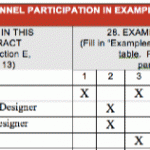
Before a RFP hits the street, it’s reasonable for the client to “go out to the industry” for input.
Do not send the client RFP language that is ambiguous. Make sure what you give them is very clear and can only have one possible interpretation.
Here’s what will happen if you don’t. Months from now, somebody at your firm will be reading this RFP. They will have a different interpretation of the language than you may have intended. This will cause a debate. If another person from your firm has a different interpretation of the language than you, who is to say which interpretation the client had.
So, even if you submit based on your originally intended interpretation, you might fail to give the client what they want.
Your interpretation isn’t the important one, it’s the client’s. Never give them ambiguous information.
If you liked this article, please subscribe below. If you want to give us your thoughts on this issue, please leave a comment below.





Matt
Avoiding ambiguity is important, of course. More important, however, is to have a prepared set of RFP questions to provide clients if they ask for help in creating an RFP. Those questions are specific to the industry and specific line of business, of course, but most importantly they are questions that:
A client/prospect asking for your help with buying something they already purchase from you/that you sell is a foundational element of building a relationship and a HUGE opportunity. Be prepared.
Good point. Thank you for contributing to the discussion.